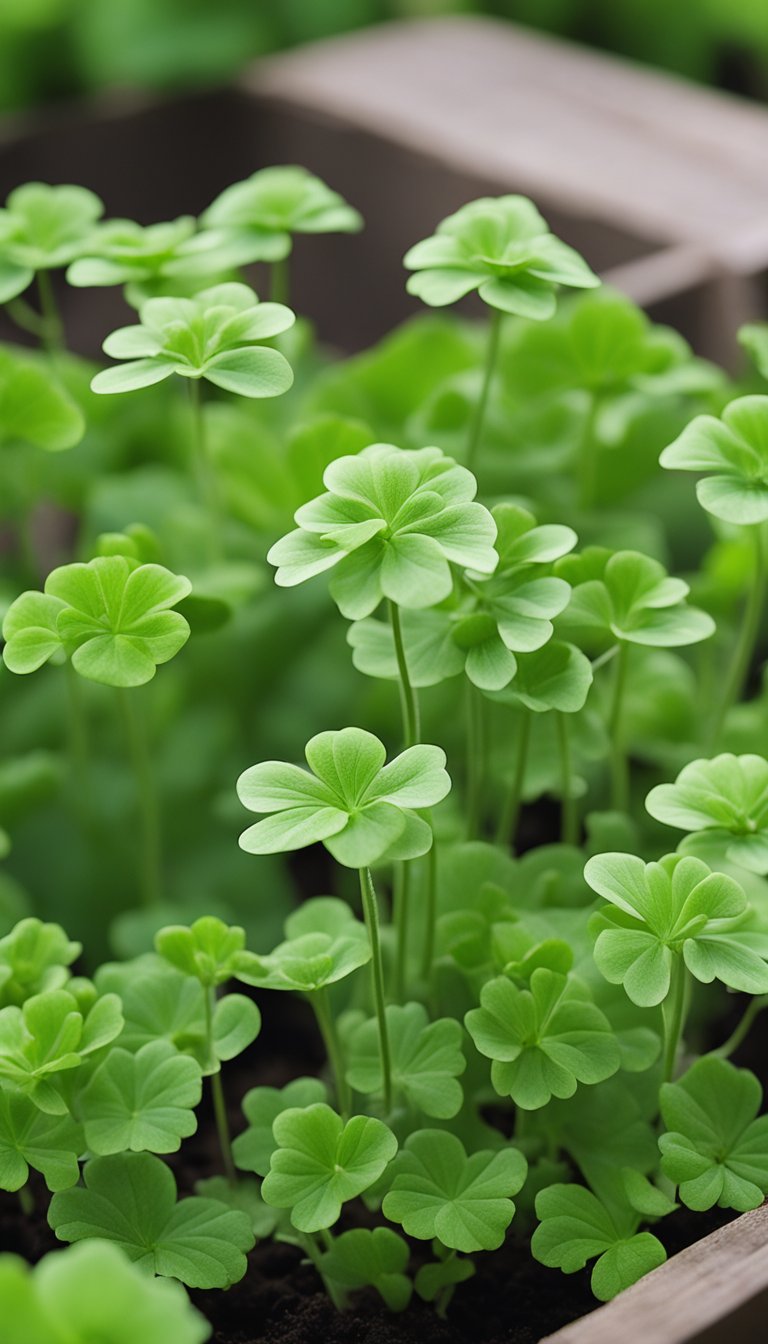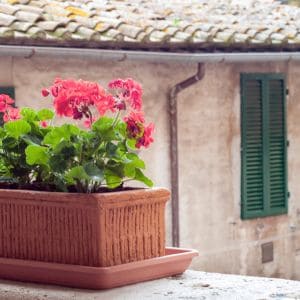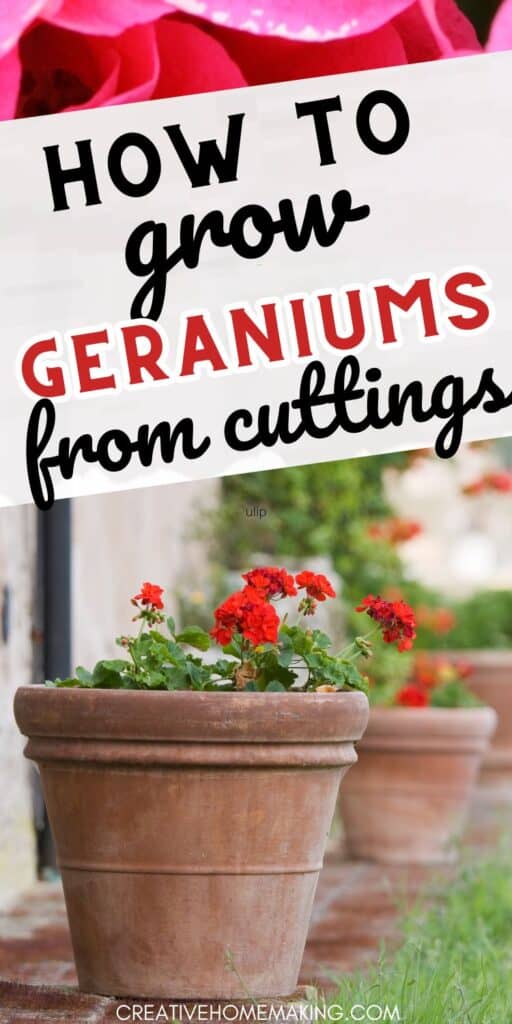Growing geraniums from cuttings is a fun and easy way to propagate these beautiful plants. Whether you’re a seasoned gardener or just starting out, taking cuttings is a great way to expand your collection of geraniums without spending a lot of money.
This post may contain affiliate links.
In this article, we’ll show you how to grow geraniums from cuttings and give you tips for success.
Before we get started, let’s talk about what cuttings are and why they’re a great way to propagate geraniums. Cuttings are pieces of a plant that you take and root to create a new plant.
When you take a cutting from a geranium, you’re essentially creating a clone of the parent plant. This means that the new plant will have all the same characteristics as the parent, including its flower color, leaf shape, and growth habit.
Plus, cuttings are a great way to save money on plants, as you can create multiple new plants from just one parent plant.
Related Article: How to Grow Geraniums in Containers
Understanding Geranium Cuttings
Types of Geraniums
Before you start propagating geraniums, it’s important to understand that there are many different types of geraniums. The most commonly propagated geraniums are pelargoniums, which are often referred to as “common geraniums”. These geraniums come in a wide variety of colors and are known for their fragrant leaves.
Benefits of Propagation
Propagating geraniums from cuttings is an easy and cost-effective way to increase your plant collection. Not only is it a fun and rewarding experience, but it also allows you to create new plants that are genetically identical to the parent plant.
This means that you can ensure that your new plants will have the same characteristics as the original plant, such as color, size, and fragrance.
To propagate geraniums, you will need to take cuttings from the parent plant. Cuttings are typically taken from the stem of the plant, just below a leaf node. A leaf node is the point on the stem where a leaf attaches.
When taking cuttings, it’s important to use a sharp, clean pair of scissors or pruning shears to avoid damaging the plant.
Once you have taken your cuttings, you can either root them in water or soil. Water propagation involves placing the cuttings in a jar of water until they develop roots, while soil propagation involves planting the cuttings directly into soil.
Both methods can be successful, but soil propagation is generally considered to be more reliable.
Related Article: How to Grow Zinnias in Pots: A Beginner’s Guide
Preparing for Propagation
Selecting the Mother Plant
When it comes to growing geraniums from cuttings, it is important to select a healthy mother plant. Choose a plant that is disease-free, has no signs of insect damage, and has strong stems and leaves. Look for a plant that is well-established and has been growing for at least a year.
Tools and Equipment Needed
Before you start propagating geraniums, you need to gather the necessary tools and equipment. Here are some items you will need:
- Sharp knife or pruners: You will need a sharp knife or pruners to make clean cuts on the mother plant and the cuttings.
- Rooting hormone: Rooting hormone is a powder or liquid that helps the cuttings develop roots more quickly. It is not essential, but it can increase your chances of success.
- Containers: You will need small containers to plant the cuttings in. You can use plastic cups, small pots, or even egg cartons.
- Potting soil: Use a well-draining potting soil that is rich in nutrients and has good water retention.
- Water: You will need to water the cuttings regularly to keep the soil moist.
It is important to keep all your tools and equipment clean and sterile to prevent the spread of disease. Use rubbing alcohol to sterilize your tools before and after each use.
How to Take Cuttings
Growing geraniums from cuttings is an easy and cost-effective way to propagate new plants. The best time to take cuttings is in the spring or early summer when the plant is actively growing. To take cuttings, follow these simple steps:
- Choose a healthy geranium plant with strong stems and plenty of leaves.
- Using a clean, sharp pair of scissors or pruning shears, cut a stem from the plant that is 4-6 inches long.
- Make the cut just below a node, which is where the leaves attach to the stem.
- Remove the lower leaves from the stem, leaving only the top few leaves.
Preparing Cuttings for Rooting
Once you have taken your cuttings, it’s important to prepare them properly to ensure they root successfully. Follow these steps to prepare your cuttings:
- Dip the cut end of the stem in rooting hormone powder to encourage root growth.
- Shake off any excess powder and make a small hole in a pot filled with moist potting soil.
- Insert the stem into the hole and gently press the soil around it to hold it in place.
- Water the soil thoroughly, and cover the pot with a plastic bag or clear plastic wrap to create a humid environment.
- Place the pot in a warm, bright location, but out of direct sunlight.
As your cuttings begin to root, they will form a callus at the cut end. This is a natural part of the rooting process and helps to protect the new roots. After a few weeks, you can remove the plastic covering and transplant the new plants into individual pots or into your garden.
Related Article: 4 Creative Ideas for Vertical Gardens
Rooting Geranium Cuttings
Growing geraniums from cuttings is an easy and cost-effective way to propagate new plants. In this section, you will learn how to root geranium cuttings successfully.

Creating the Right Environment
To root geranium cuttings successfully, you need to create the right environment. Here are some tips to help you get started:
- Water: Make sure the cuttings are well hydrated before you start. Water them thoroughly a day or two before you take the cuttings.
- Potting Mix: Use a well-draining potting mix that is rich in nutrients. You can make your own mix by combining equal parts of peat moss, perlite, and vermiculite.
- Humidity: Geranium cuttings need high humidity to root successfully. You can increase humidity by covering the cuttings with a plastic bag or placing them in a propagator.
- Temperature: Geranium cuttings root best at temperatures between 65°F and 75°F. If your home is cooler than this, consider using a heat mat to warm the soil.
Related Article: How to Grow Lavender from Cuttings
Caring for Cuttings During Rooting
Once you have created the right environment, it’s time to care for your cuttings. Here are some tips to help you care for your geranium cuttings during rooting:
- Drainage: Make sure the pot has good drainage to prevent the soil from becoming waterlogged. You can add a layer of gravel to the bottom of the pot to improve drainage.
- Heat Mat: If your home is cooler than 65°F, consider using a heat mat to warm the soil and promote root growth.
- Plastic Bag: Covering the pot with a plastic bag helps to increase humidity and prevent the soil from drying out. Make sure to remove the bag for a few hours each day to prevent mold growth.
- Propagator: If you have a propagator, you can use it to create the perfect environment for your geranium cuttings. A propagator will provide the right amount of heat, humidity, and light to help your cuttings root quickly.
Potting and Plant Care
Transplanting Rooted Cuttings
Once your geranium cuttings have rooted, it’s time to transplant them into individual pots. Choose a pot that is slightly larger than the cutting’s root ball, with drainage holes at the bottom.
Fill the pot with a well-draining potting soil mix, leaving enough space at the top for watering.
Gently remove the cutting from its original container and loosen any tangled roots. Place the cutting in the center of the pot and add more soil around it, pressing it down gently to remove any air pockets.
Water the soil thoroughly, making sure that excess water drains out of the bottom of the pot.
Ongoing Care and Maintenance
Geraniums are relatively easy to care for, but they do require some attention to keep them healthy and blooming. Here are some tips to keep your geraniums thriving:
- Water regularly, but don’t overwater. Geraniums prefer to be slightly dry between waterings, so wait until the top inch of soil is dry before watering again.
- Fertilize once a month during the growing season with a balanced fertilizer. Follow the instructions on the package for application rates.
- Pinch back the tips of the stems regularly to encourage bushy growth and more blooms.
- Deadhead spent flowers regularly to encourage more blooms.
- Keep an eye out for pests such as spider mites and aphids, and treat them promptly if you notice any infestations.
Troubleshooting Common Issues
Dealing with Disease and Pests
Unfortunately, geraniums are susceptible to a variety of diseases and pests. Here are some common issues and how to deal with them:
- Powdery mildew: This fungal disease appears as a white powdery substance on the leaves. To prevent it, make sure your plants have good air circulation and avoid overhead watering. If you do notice powdery mildew, remove infected leaves and treat with a fungicide.
- Spider mites: These tiny pests can cause yellowing leaves and webbing on the plant. To prevent them, mist your plants regularly and keep the air humid. If you do notice spider mites, spray your plants with insecticidal soap.
Preventing Rot and Other Problems
Geraniums are also prone to rot and other problems. Here’s how to prevent them:
- Overwatering: Geraniums don’t like to be overwatered, so make sure the soil is well-draining and allow it to dry out slightly between waterings.
- Root rot: This can occur if the soil is too wet or if the plant is in a container without proper drainage. To prevent it, make sure your plants are in well-draining soil and containers with drainage holes.
- Propagation problems: If you’re having trouble getting your cuttings to root, make sure you’re using healthy, disease-free plants and that your cuttings are taken from the right part of the plant. You can also try using a rooting hormone to encourage rooting.
Seasonal Considerations
Best Time to Propagate
Geraniums can be propagated from cuttings during the spring and summer months. This is the time when the plant is actively growing and has plenty of energy to devote to producing new roots and leaves.
It’s best to take cuttings in the morning when the plant is fully hydrated and has the most energy.
Overwintering and Year-Round Care
Geraniums are sensitive to frost and should be brought indoors before the first frost of the season.
Overwintering geraniums is easy – simply bring the plant indoors and place it in a sunny location. Keep the soil moist, but not waterlogged, and fertilize once a month.
During the winter months, geraniums will require less water and fertilizer than during the growing season. Be sure to check the soil moisture level before watering, and only water when the soil is dry to the touch.
In the spring, you can begin to fertilize your geraniums again and gradually increase the amount of water as the plant begins to grow. By the time summer arrives, your geraniums should be ready to be propagated again. With proper care, your geraniums will thrive year-round.
Frequently Asked Questions
What is the best soil mix for rooting geranium cuttings?
A well-draining soil mix is best for rooting geranium cuttings. You can use a mix of perlite, sand, and peat moss in equal parts to create an ideal soil mix. Make sure the soil is moist but not waterlogged before planting the cuttings.
How can you ensure geranium cuttings survive over winter?
Geraniums are sensitive to cold temperatures, so it is important to keep them indoors during the winter months. Keep the plants in a well-lit area with temperatures between 60-70°F. Water the plants sparingly during the winter months to prevent root rot.
What steps are involved in propagating geraniums from cuttings indoors?
To propagate geraniums from cuttings indoors, follow these steps:
- Take a cutting from a healthy geranium plant
- Remove the lower leaves from the stem
- Dip the cut end of the stem in rooting hormone
- Plant the stem in a well-draining soil mix
- Keep the soil moist and the plant in a well-lit area
- Wait for the plant to root and grow
How long should I expect to wait before geranium cuttings start to root?
Geranium cuttings can take anywhere from 2-4 weeks to root. However, some cuttings may take longer depending on the environmental conditions.
Is it possible to root geranium cuttings in water, and if so, how?
Yes, it is possible to root geranium cuttings in water. Simply take a cutting from a healthy geranium plant and place it in a glass of water. Change the water every few days and wait for the plant to root. Once the roots have formed, transplant the cutting into a well-draining soil mix.
When is the ideal time of year to take geranium cuttings for propagation?
The ideal time of year to take geranium cuttings for propagation is in the spring or early summer when the plant is actively growing. Avoid taking cuttings during the winter months when the plant is dormant.
Follow my gardening board on Pinterest.





